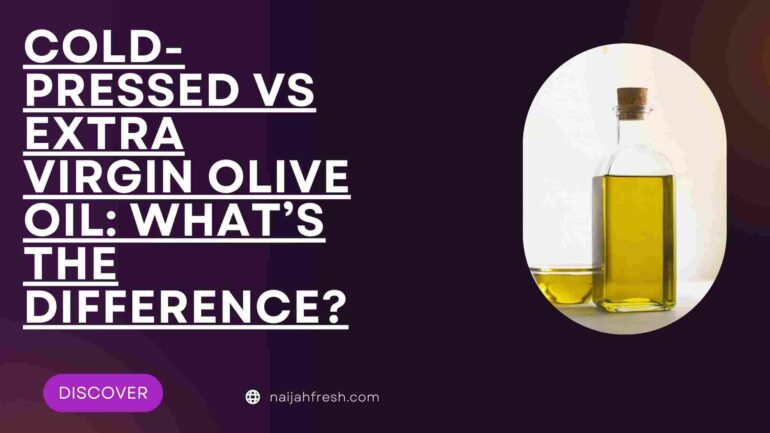When shopping for olive oil, you’ve likely seen labels that say cold-pressed or extra virgin. But here’s the catch: most people use these terms interchangeably—even though they’re not exactly the same.
So, what sets them apart?
Understanding the difference can help you make smarter choices in the kitchen, whether you’re drizzling oil on a salad or cooking a healthy meal. Let’s dive into what these terms really mean—and why it matters to your health, flavour, and wallet.
What Is Cold-Pressed Olive Oil?
Let’s break it down.
Cold-pressed olive oil is made by mechanically pressing olives without using heat or chemicals. That’s right — no heat, no shortcuts.
Why does that matter?
Because heat can degrade the quality of the oil. Cold pressing helps preserve the natural antioxidants, nutrients, and flavour of the olives. The result? A healthier, more wholesome oil.
Here’s what sets cold-pressed olive oil apart:
- Temperature matters: The pressing must happen below 27°C (80°F) to be officially “cold-pressed.”
- Mechanical process only: No solvents or industrial refining.
- Nutrient-rich: Vitamins E and K, and powerful antioxidants like polyphenols stay intact.
But is cold-pressed always extra virgin?
Not necessarily — and we’ll get into that shortly.
First, let’s look at what makes an olive oil extra virgin.
What Is Extra Virgin Olive Oil?
Now, here’s where things get interesting.
“Extra virgin” isn’t just a fancy label — it’s the highest quality grade of olive oil you can get.
But wait — what does extra virgin really mean?
Here’s the deal:
To be classified as extra virgin, an olive oil must meet strict standards set by international bodies like the International Olive Council (IOC) or the European Union.
Here’s what qualifies it:
- Cold-pressed: Yes, it must be mechanically extracted without heat or chemicals — so it’s always cold-pressed.
- Low acidity: The oil must have a free oleic acid level of less than 0.8%.
- No defects: It should be free from sensory flaws like rancidity or fustiness. The aroma and taste should be fruity, fresh, and balanced.
So, to sum it up:
All extra virgin olive oil is cold-pressed — but not all cold-pressed oil qualifies as extra virgin.
Why not? Because cold-pressed oils can still have flaws in flavour, aroma, or higher acidity that disqualify them from the “extra virgin” title.
Cold-Pressed vs Extra Virgin Olive Oil: What Sets Them Apart?
At first glance, the terms cold-pressed and extra virgin might sound interchangeable.
But here’s the truth:
They’re related, but not the same.
Let’s unpack the key differences that matter — so you’re not misled by marketing jargon.
1. Definition & Processing
- Cold-Pressed Olive Oil
Refers to how the oil is extracted — specifically, it’s made by mechanically pressing olives without heat or chemicals (usually under 27°C or 80°F).
This method helps preserve nutrients, antioxidants, and natural flavour. - Extra Virgin Olive Oil (EVOO)
Goes a step further — it’s cold-pressed, yes, but also meets very strict quality standards. That includes taste, aroma, and chemical composition (like low acidity).
EVOO is the purest, most nutrient-rich grade of olive oil.
In simple terms: Cold-pressed is a method. Extra virgin is a quality grade that requires cold pressing plus much more.
2. Acidity Level
Here’s where the science kicks in.
- Cold-Pressed Oil
May have variable acidity levels. If the free oleic acid content is higher than 0.8%, it can’t be classified as extra virgin. - Extra Virgin Olive Oil
Must have an acidity level below 0.8%, which indicates minimal processing and high freshness.
Why does this matter?
Lower acidity means better flavour, longer shelf life, and higher antioxidant levels.
3. Taste and Aroma
- Cold-Pressed Oil
Quality can vary — it may taste slightly flat or even have minor flaws depending on the olives and handling. - EVOO
Has a fresh, fruity, sometimes peppery flavour — and no off smells. Think of it as the “first juice” of healthy, hand-picked olives.
Want oil that tastes amazing in salads, dips, or straight from the spoon? Go for extra virgin.
Health Benefits of Olive Oil: Which One Is Better for You?
Here’s the million-pound question:
Is extra virgin olive oil healthier than just cold-pressed olive oil?
Let’s settle it.
Extra Virgin Olive Oil: The Gold Standard for Health
Because EVOO is both cold-pressed and strictly graded, it retains:
- Powerful antioxidants like polyphenols — known to fight inflammation and oxidative stress.
- Heart-healthy fats, especially oleic acid, which can help reduce bad cholesterol (LDL) and boost the good one (HDL).
- Brain-protective compounds linked to lower risks of cognitive decline.
- Anti-cancer properties shown in various studies thanks to its richness in bioactive compounds.
In fact, EVOO is a core ingredient in the Mediterranean diet — consistently ranked among the healthiest diets in the world.
Cold-Pressed Oil (Not Extra Virgin): Still Good, But…
While still healthier than heavily refined oils, regular cold-pressed olive oil might:
- Have slightly fewer antioxidants if it comes from lower-quality olives.
- Contain more free fatty acids, which can reduce stability and health benefits.
- Taste milder, with a less vibrant nutritional profile.
Bottom line: All extra virgin olive oil is cold-pressed, but not all cold-pressed oil is extra virgin. EVOO gives you the full health package.
Cooking Uses: When to Use Each One
So, you’ve got a bottle of cold-pressed olive oil and maybe even a premium extra virgin one.
But how do you actually use them in the kitchen?
Let’s break it down!Extra Virgin Olive Oil: Best for Cold Dishes & Light Cooking
EVOO has a low to moderate smoke point (about 160–190°C or 320–375°F). This makes it ideal for:
- Salad dressings — Its bold, fruity flavour adds life to greens.
- Drizzling over cooked veggies, meats, soups, or bread.
- Dips like hummus or olive oil and balsamic vinegar with sourdough.
- Light sautéing at low temperatures.
Pro Tip: EVOO’s rich taste can overpower delicate dishes — but it shines in Mediterranean recipes and cold preparations!
Cold-Pressed Olive Oil (Not EVOO): Better for Medium-Heat Cooking
This type still retains a good chunk of nutrients and flavour, but with a slightly higher smoke point than some unfiltered EVOOs. It’s great for:
- Roasting vegetables or fish.
- Pan-frying at medium temperatures.
- Baking healthy muffins or savoury loaves.
- Everyday cooking where you want a balance of flavour and heat stability.
Avoid high-heat deep frying with either oil. For very high temps, use oils like avocado or refined olive oil.
How to Spot Fake or Low-Quality Olive Oil
Unfortunately, not all olive oils are created equal, and many products on the market don’t live up to their premium claims. So, how can you tell if you’re getting genuine, high-quality olive oil? Here are some key things to look out for:
1. Check the Label: The Truth Lies There!
- Look for ‘Cold-Pressed’ or ‘First Cold Press’: If it’s cold-pressed, it means the oil was extracted without heat, preserving its full flavour and nutrients.
- Extra Virgin (EVOO): Ensure it’s labeled “extra virgin” to guarantee minimal processing and high-quality standards.
- Origin Information: Genuine olive oils often specify the origin of the olives. If the label is vague or doesn’t specify, that’s a red flag.
Pro Tip: Choose olive oils that list a harvest date or use-by date. Freshness matters, and oil loses its quality with age!
2. Price Matters!
Good olive oil isn’t cheap. If you’re seeing a bottle priced suspiciously low, it may be diluted with cheaper oils. Extra virgin olive oil should be priced based on its quality, processing method, and region of origin. If it’s too cheap, there’s probably something off about it.
Heads Up: Be cautious of brands offering large quantities of “EVOO” at incredibly low prices — they might be cutting corners.
3. Look at the Bottle: The Right Storage is Crucial
High-quality olive oil should come in a dark glass bottle or a tin container.
Why? Light and air can degrade olive oil quickly, diminishing its flavour and health benefits. A transparent bottle is a sign that the company may not be as committed to preserving the oil’s quality.
Note: Avoid clear plastic bottles — they let in light and oxygen, ruining the oil’s freshness over time.
4. The Taste Test: How Does It Feel on Your Tongue?
The taste should be fruity, grassy, and slightly peppery — a sign that the oil is fresh and full of antioxidants. If it tastes flat, rancid, or lacks flavour, it’s likely old or low-quality oil.
Tip: Take a small sip of olive oil. If it makes your throat feel a little scratchy or tingly, that’s a good sign — it means the oil has healthy polyphenols!
Conclusion
In summary, when it comes to choosing between cold-pressed olive oil and extra virgin olive oil, the key differences lie in the extraction process, quality, and health benefits. Cold-pressed oils are extracted using minimal heat, ensuring the preservation of nutrients and antioxidants, while extra virgin olive oil represents the highest quality of olive oil, made from the first cold press with no chemicals or refining involved.
To recap, here are the main things to remember when choosing olive oil:
- Extra virgin is the healthiest option with the highest quality.
- Look for cold-pressed or first cold press for better flavor and nutrition.
- Ensure the oil is stored in dark glass bottles or tin to protect from light and heat.
- Check for a harvest date or expiration date to ensure freshness.
- Avoid oils labeled as “light” or “pure,” as they are often highly refined.
Pro tip: Always read the labels carefully before making a purchase.
Looking for authentic, high-quality cold-pressed olive oil? Try ours — freshly extracted and rich in flavor and nutrients. Click here to explore and add it to your pantry today!


